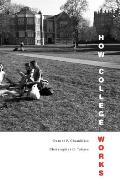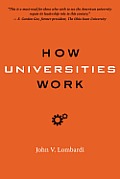- About
- Programs
- Issues
- Academic Freedom
- Political Attacks on Higher Education
- Resources on Collective Bargaining
- Shared Governance
- Campus Protests
- Faculty Compensation
- Racial Justice
- Diversity in Higher Ed
- Financial Crisis
- Privatization and OPMs
- Contingent Faculty Positions
- Tenure
- Workplace Issues
- Gender and Sexuality in Higher Ed
- Targeted Harassment
- Intellectual Property & Copyright
- Civility
- The Family and Medical Leave Act
- Pregnancy in the Academy
- Publications
- Data
- News
- Membership
- Chapters
Love or Money
How College Works by Daniel F. Chambliss and Christopher G. Takacs. Cambridge, MA: Harvard University Press, 2014.
How Universities Work John V. Lombardi. Baltimore: Johns Hopkins University Press, 2013.
This succinctly titled pair—How College Works, by Daniel F. Chambliss and Christopher G. Takacs, and How Universities Work, by John V. Lombardi—offers a series of equally succinct explanations: of “Entering,” “Learning,” “Belonging,” and “Finishing” college; and of “Management,” “Teaching,” “Finance,” and “Measurement” at universities. In each case, the authors are explicit about the particularity of their subjects, elite liberal arts colleges or first-rank research universities, while modestly proposing that their conclusions might be usefully put to work at other kinds of institutions at other levels of the hierarchy of American higher education. How College Works, based on ten years of multifaceted Mellon-funded research centered on Hamilton College, is about how colleges work for others. How Universities Work, a distillation of Lombardi’s own experience as a university administrator and president, is, on the contrary, about how universities work for themselves.
Morality and economics, respectively, are the frames of these guides for those who would guide our institutions. College administration is at base a matter of moral questions for Chambliss and Takacs. Lombardi assumes global economic prosperity as the context of the research university. The focus of the former is students, and of the latter “competitiveness”; colleges seek student satisfaction, perhaps even happiness; universities must pursue preeminence or stagnate and decline. This divergence of these two analyses is both blurred and clarified by their simultaneous convergence. Both books begin and end with a focus on people. But their people are clearly differentiated: Chambliss and Takacs discuss “good people” and Lombardi discusses “high quality people.”
The shared focus on people produces a common emphasis on the complexities of administration in practice and on the difficulties of producing quick or fundamental change, as well as a common skepticism about grand ambitions to revise institutions in the abstract or in detail. Although the careers of presidents and deans, Chambliss and Takacs observe, “rely on launching splashy programs . . . with fundraising titles like ‘The Campaign for Creativity’ or ‘Exceeding All Expectations’” that “make great fodder for alumni speeches, addresses to the Board of Trustees[,] . . . the regional and even national press,” the administrators touting such schemes know they will not really improve the education offered. Lombardi, citing pressure from clueless trustees, also scorns the empty rhetoric of “Dynamic, Disruptive change,” and “new initiatives with innovative programs.”
On the grounds of lack of effect or waste of resources, these authors also agree on three subjects that have generated rhetoric and work at every type of institution in recent years: strategic planning, technology, and assessment. Strategic planning is dismissed across the board as a faddish corollary of administrative grand plans and sweeping visions, “a rationalist’s utopia,” as Chambliss and Takacs put it, inevitably in practice a profound waste of time and money in its attempts to “microengineer human behavior.” The books’ shared lack of enthusiasm for the rush to online learning has predictably different bases. Lombardi, arguing that wise university leaders resist “the wild waves of technological innovation . . . until the experience of others in the marketplace permits a realistic cost-benefit analysis,” is concerned about the finances. Chambliss and Takacs doubt the contribution to education: “online video lectures . . . too often go unattended, or if watched will not be studied.” In both works, the implementation of elaborate new forms of assessment, imposed by political forces through accreditation agencies, is accepted as unavoidable. But Lombardi views these assessment instruments as a much too fine-grained way of addressing the need and possibilities for measuring quality in the university. He outlines instead a more complex set of subjects to be tracked and proposes ways of keeping track. For Chambliss and Takacs, the systems currently being put into place are too coarse to capture the experience of individual students at the college level.
All three authors see education as what Lombardi calls a “handicraft activity” in which the fundamental process involves an instructor engaging students. This produces the only limit, in the end, of Lombardi’s economic model: “Universities represent a special category of individualized transaction that links teachers and students in small numbers to achieve a high-touch interaction perceived to be of great value. This format does not scale well.” The limit, however, is high: Lombardi continues, “Traditional universities rarely grow much beyond an enrollment of forty to fifty thousand students before splitting into smaller subunits that are separately operated and administered.” Chambliss and Takacs, on a much smaller scale, concur: “Good colleges have always been fundamentally human institutions.” Faculty are central to both accounts yet also differentially peripheral, subordinate to administration in the university setting and to students in the college model.
Here the consequences of their different conceptions of people—“high quality” or “good”—are most apparent. Lombardi is emphatic that a university’s quality and competitiveness depend on the “quality and competitiveness of its faculty.” He roundly rejects what he refers to as the “industrial model” of the university. Faculty members are not labor. But they also are not management—though he acknowledges the role of faculty in governance, where their chief task is to monitor the quality of their peers and ultimately to replace themselves, but always with higher-quality versions of themselves. Centrally, in his view, the faculty are the capital of the institution. They must be acquired and supported by the administration alongside the high-quality students the university must focus on attracting. Unsurprisingly, given his emphasis on competition, Lombardi assumes a finite pool of high-quality people, faculty or students, over whom each actually or potentially first-rate university is fighting. At the same time, the institutions he describes do not seem to have much to do with producing such people, either faculty or students.
For Chambliss and Takacs, the key is the benefit produced by the good people on whom colleges rely: “a college—at least insofar as it offers real benefits—is less a collection of programs than a gathering of people.” This is because, they argue quite persuasively, “the fundamental problem of American higher education is no longer the availability of content, but rather the availability of motivation,” and human contact is the only consistent source of motivation their elaborate study revealed. That is why “what really matters in college is who meets whom, and when.” The faculty have value because of their role in the students’ experience. You go to class with the faculty members you have, not the faculty you might want. If, as they claim, “remarkably small actions can at least potentially produce huge results,” and a few teachers have a hugely disproportionate effect on students’ lives, which their data show to be the case, colleges should maximize the contact between those faculty members and the students. While those small actions include a willingness to mentor students, in stark contrast to the current emphasis on strategic planning, online education, and assessment, they propose that one of the most influential factors in a student’s education is literally whether or not the faculty invite her or him to dinner. Unfortunately, the content of classes is as immaterial to Chambliss and Takacs’s college as the content of research is to Lombardi’s university: “Curriculum is nice, but may not be fundamental for a good college,” Chambliss and Takacs write. “But good people, brought together in the right ways, we suspect, are both necessary and perhaps even sufficient to create a good college.”
The gap between an emphasis on high quality and one on good people is, then, where the difference between these studies emerges. The people focus of these two books is a means of pushing back at pressures to scale up practices (online) or to double down on students and faculty (through assessment). This focus softens the edges of the starkly competitive model. And it is an entirely plausible result of a detailed exploration of what works in the college setting. Whether or not we see ourselves as high-quality or good people, How College Works offers support to all faculty members interested in resisting the economic model imposed with increasing force on all colleges and universities these days. I will continue inviting my students over for dinner.





